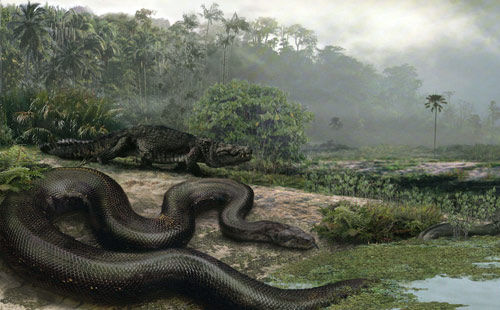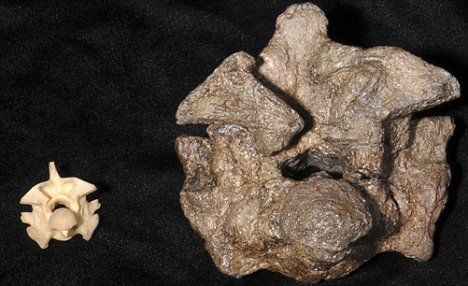The largest snake the world has ever known -- as long as a school bus and as heavy as a small car -- ruled tropical ecosystems only six million years after the demise of the fearsome Tyrannosaurus rex, according to a new discovery to be published on Thursday in the journal Nature.
 |
|
An artist's rendering shows the colossal prehistoric snake Titanoboa cerrejonensis, whose remains were found in a Colombian coal mine. This monster was the largest snake ever known to have lived. Titanoboa was at least 43 feet (13 meters) long and weighed 2,500 pounds (1,140 kg), scientists wrote in the journal Nature. [University of Florida]
|
Partial skeletons of a new giant, boa constrictor-like snake named "Titanoboa" found in Colombia by an international team of scientists and now at the University of Florida (UF) are estimated to be 42 to 45 feet long, said Jonathan Bloch, a UF vertebrate paleontologist who co-led the expedition with Carlos Jaramillo, a paleobotanist from the Smithsonian Tropical Research Institute in Panama.
Researchers say the extinct snake was even larger than the wildest dreams of directors of modern horror movies.
"Truly enormous snakes really spark people's imagination, but reality has exceeded the fantasies of Hollywood," said Bloch, who is studying the snake at the Florida Museum of Natural History on the UF campus. "The snake that tried to eat Jennifer Lopez in the movie 'Anaconda' is not as big as the one we found."
Jason Head, a paleontologist at the University of Toronto in Mississauga and the paper's senior author, described it this way: "The snake's body was so wide that if it were moving down the hall and decided to come into my office to eat me, it would literally have to squeeze through the door."
Besides tipping the scales at an estimated 1.25 tons, the snake lived during the Paleocene Epoch, a 10-million-year period immediately following the extinction of the dinosaurs 65 million years ago, Bloch said.
 |
|
An undated handout image from the British science magazine Nature shows the vetebrae of the world's biggest snake with the vertebrae (in white) of a modern 17 foot Anaconda. The report said that the boa-like behemoth ruled the tropical rainforests of what is now Colombia some 60 million years ago.
|
The scientists also found many skeletons of giant turtles and extinct primitive crocodile relatives that likely were eaten by the snake, he said. "Prior to our work, there had been no fossil vertebrates found between 65 million and 55 million years ago in tropical South America, leaving us with a very poor understanding of what life was like in the northern Neotropics," he said.